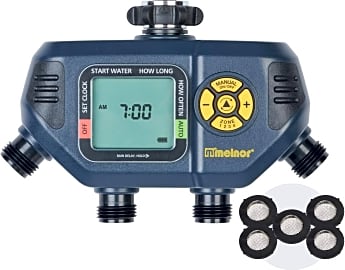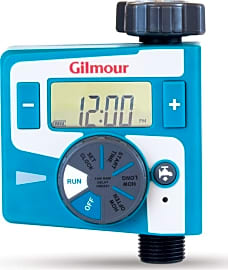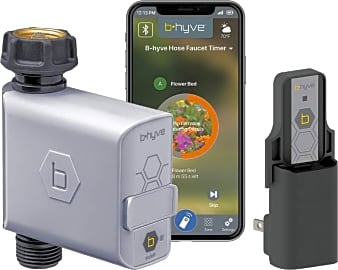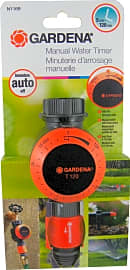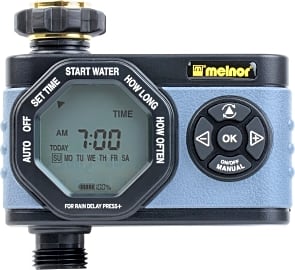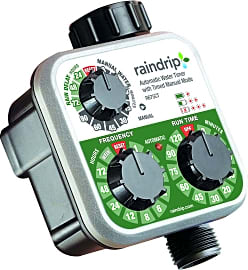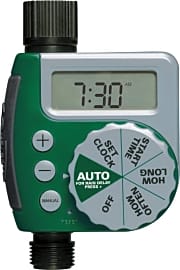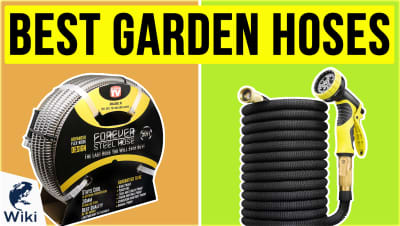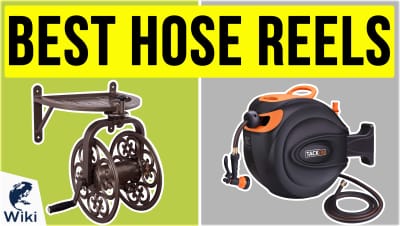The 10 Best Hose Timers

This wiki has been updated 41 times since it was first published in August of 2015. Did you know that more people on the planet have a mobile phone than access to clean drinking water? You can do your part to help conserve this precious resource and make sure you don't run afoul of local watering and sprinkler regulations while still maintaining your yard by using one of these programmable hose timers. They can take the guesswork and stress out of ongoing lawn care. When users buy our independently chosen editorial recommendations, we may earn commissions to help fund the Wiki.
Editor's Notes
July 31, 2020:
Hose timers aren't just about convenience. They are also a very effective method for conserving water and can help ensure your lawn and garden thrive. They allow for precise control over your watering cycles, so your plants don't dry out and wilt, and eliminate the chances of forgetting you left the spigot running, so you never wind up with an unexpected utility bill at the end of the month.
During our most recent update, we felt the need to remove the Zilker Wireless. We didn't like that it couldn't be used with Android devices, which immediately means that a large portion of our readers wouldn't be able to take advantage of it. There were also simply too many reports of it malfunctioning in some way or another. Additionally, most didn't find it to be user friendly. Taking its place is the Orbit B-Hyve, which also integrates with smart homes via the included hub, and can be controlled through an iOS or Android app on your phone or tablet, or via Amazon's Alexa. While we will be the first to admit that it also suffers from some reliability issues, it does seem to be better than the Zilker in that regards, and we believe it is currently one of the best smart option available on the market. Plus, programming it is more straightforward than with the Zilker.
The Melnor AquaTimer 4-Zone is another new addition to the list during the latest update. Previously, we included the Melnor Hydrologic Single-Outlet, and we still stand behind that recommendation, but figured we need to also add something for homes with multiple watering zones. Other than differing in the number of lines, they both offer similar features, such as the ability to set up to 24 watering cycles a day, a sturdy metal connection nut, and a rain delay function.
We also decided to replace the Claber Aquauno Logica with the Claber Aquauno Select. The latter offers manual override, which is a convenient feature the former didn't have, and it allows for a bit more customization of watering cycles. Coming from the same brand is the Claber Aquadue Duplo Evolution, which is one of our most highly recommended models. It surpasses both of the other two options in regards to versatile scheduling, and it also has two lines.
May 07, 2019:
Because it offers the ability to connect two hoses and is more durable than much of the competition, we believe that the Claber Duplo Evolution remains a top hose timer for many users. At first glance, it looks more complicated than some, but most find its use intuitive and the extra functionality worth it. The price is a bit steep, however; if this is an issue, you might look at either the Gideon Digital or the Gilmour 300GTS instead. They aren't quite as robust, but for most homeowners with casual needs, they should suit just fine. When it comes to smart options, we feel that currently, the Zilker Wireless is a better bet than the RainRobot Smart Drip, which has a handful of small, irritating drawbacks. Note that the Zilker is not Android compatible at this time and thus is not for everyone. Finally, we removed the Orbit Digital but left the manual Orbit 1 Outlet. The Orbit models are, in theory, a fine solution, but in practice, they tend to have occasional durability issues. The manual model does have an easy to use design, though.
Special Honors
The Lawn Institute If you are considering buying a hose timer, then you probably care about how your lawn looks. The Lawn Institute is a great resource that contains tons of information covering everything from preparing your property for seed to selecting the right kind of grass for your location to watering and maintenance tips. thelawninstitute.org
Interval Watering For A Healthy Yard And Garden
With the right hose times, at least you can manage the last factor with ease, and without the need for an expensive built in sprinkler system.
Routines are as healthy for plants as they are for humans; all living things, in fact, be they flora or fauna, benefit from a reliable schedule with minimal alteration. For a human being, this may involve waking up and having their morning coffee at approximately the same hour and making sure to squeeze in an afternoon stroll or nap.
For plants, including that lawn you treasure, ideal routines are more about watering cycles than about naps or walks. The cycle, or the duration of each watering session and the frequency with which a yard is watered, has a huge impact on the overall health of the grass, especially during the hot summer season. So too is the growth of flowering plants and food bearing plants directly impacted by watering routines.
Consider summertime lawn watering: the ideal way to water an established lawn during the summer, you need to water three times a week and let the water penetrate down to about a half foot below the surface at each watering session. (Use a shovel to lift some soil to find how long it takes to reach this saturation level).
Once you know the time needed for this depth of watering, allow each watering session to last that long until the season or circumstances (rainfall or heatwave and drought, for example) change. New lawns require even more specific watering cycles. And this is just the grass we're talking about.
Yes, it can be a headache, or at least a major inconvenience, to establish and maintain an ideal watering schedule for your lawn, landscaping, or garden.
If you want to grow a lush green lawn, big, bright flowers, or succulent, hearty tomatoes, you need to pay attention to the soil, the sunlight, and the water. With the right hose times, at least you can manage the last factor with ease, and without the need for an expensive built in sprinkler system.
Choosing A Hose Timer
Before you choose a hose timer, you need to consider what you're watering and how. That is to ask if you are watering a single plot of lawn with a single oscillating or rotating sprinkler? Or are you using a drip system to water a number of food bearing plants in your edible garden? Or are you hydrating hedges and shrubs around the periphery of your property? Or, of course, are you watering a combination of these plants and/or more?
Or are you hydrating hedges and shrubs around the periphery of your property?
For the simplest, single purpose application, by all means choose the simplest single valve hose timer. If you tend to be home anyway, then don't bother with a battery-powered option when there are manual hose timers that are almost foolproof thanks to their simplicity and are priced in range for most budgets.
However, using one of these analog style hose timers does mean in-person interaction each time you want to water, which may seem to some people counter intuitive: why use a hose timer at all when you have to set it each time? (e.g. Price is a factor there, but this concern is entirely with merit.)
Many electronically controlled hose timers are easy to program once you get to know them, thanks to clear LCD screens and push button controls, but do be ready for a learning process the first few times you set up a watering routine: it seems that every hose timer has a different interface as far as valve selection, duration input, frequency of watering sessions, and so on. What most good electronic hose timers also feature is a rain delay feature that makes it easy to bypass a watering session when it is actively raining or after a recent downpour did the work for you.
And then lastly you must consider the number of valves you'll need. Few hose timers allow you to control more than three valves (i.e. three different areas and the hardware irrigating them) at once, so if you have a large property or one requiring intricate watering, you might need to consider getting multiple hose timers -- the control and adaptability this will provide you should be seen as much as a benefit as a burden of added cost, though.
Using A Hose Timer
All standard hose timers can be simple screwed onto a standard outdoor spigot, which is to say the spigot will be the male end, the timer possessed of two female ends, one for attachment to the source, one for receiving the hose or drip lines.
Next make sure to always use fresh batteries when setting up electronic hose timers.
Make sure the threads of the spigot and the timer are clean and in good shape before attaching the timer, as poor threads and a bad connection will result in wasted water and ineffective watering. You can use a bit of Teflon tape (AKA plumber's tape) to improve the seal between the threads, and make sure that any rubber washers that should be in place on the end of the hose or in the timer are there and are in good shape.
Next make sure to always use fresh batteries when setting up electronic hose timers. These units use surprisingly little power, but you might not notice that their power source has failed for many days, and this can hurt your lawn or plants. Plan to switch batteries even before the manual says they require refreshing; it's cheaper to replace batteries than to re-sod a lawn.
Then simply program the timer as per the directions and to suit the needs of your grass and other plants.



